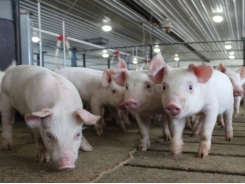Three ways piglet diets can benefit from wheat gluten

Wheat gluten is the ideal source of protein to replace not only the protein fraction of animal plasma but also to serve as a replacement for its high glutamine contribution
Wheat gluten is one of the most important proteins in wheat. Lately, it has been used in piglet diets with promising results.
Wheat gluten is a well-known compound in wheat flour that gives common bread its elastic structure. Isolated wheat gluten has been used in piglet diets as a source of protein, as a functional ingredient (it is rich in glutamine), and even as a partial replacement to animal plasma. The last function has drawn the most attention due to the expensive nature of animal plasma, whereas wheat gluten costs considerably less.
1/ Highly digestible protein source
Wheat gluten is deficient in lysine, threonine, methionine and tryptophan when compared to piglet standard nutrient requirements. Nevertheless, wheat gluten is highly digestible. For example, it has been reported that, in pigs, wheat gluten amino acids are more digestible than amino acids in fish meal, which is considered of extremely high biological value. In well-balanced diets, it has been shown that weaned pigs fed diets with wheat gluten had comparable weight gain with pigs fed diets based on milk protein and even greater performance than pigs fed simple diets based on soybean protein.
Indeed, the digestibility of nitrogen, its biological value and retention of nitrogen for diets with flash- and spray-dried wheat gluten, and two enzymatically modified wheat gluten products have all been shown to be significantly greater than in soybean meal (Figure 1). In trials where piglets were fed diets with conventional highly digestible protein sources (skim milk, whey, soybean protein isolate) versus diets based on wheat gluten, it was shown that wheat gluten can replace dried skim milk without sacrificing growth performance. Commercially, wheat gluten is also used with success in all-vegetable piglet diets and in soybean-free piglet diets.
In brief, it can be concluded that wheat gluten as a source of protein is at least equal to most common protein sources of high quality used in piglet diets, and it can be used to replace fish meal, skim milk protein and animal plasma protein (with the addition of immunoglobulins) depending on prices and overall formula composition.
2/ Rich source of glutamine
Research has shown that adding up to 1.5 percent glutamine enhances gastrointestinal health, and this is usually associated with improved growth performance post-weaning (Figure 2). Of course, such high levels of glutamine are impractical. It has been further suggested that part of the beneficial effect of animal plasma can be attributed to its rich glutamine content. Unfortunately, crystalline glutamine is not commercially available at affordable prices, and, as such, one of the best and most affordable sources of glutamine remains wheat gluten. Wheat gluten contains about 25 percent glutamine.
3/ Wheat gluten versus animal plasma
It has been demonstrated that growth performance is enhanced when piglets are fed diets based on animal plasma or wheat gluten, but best results are obtained when both ingredients are present. A series of trials from Kansas State University illustrated these effects of replacing plasma with wheat gluten (Figure 3).
From these trials, it is apparent that a blend of animal plasma and wheat gluten gives greater overall growth performance, even compared to just animal plasma alone, while reducing diet cost significantly. Complete replacement of animal plasma by wheat gluten is clearly not possible without an alternative source of immunoglobulins, which cannot be provided by wheat gluten. Furthermore, commercial evidence suggests that by using a suitable source of immunoglobulins (derived from hyper immunized eggs), it is possible to fully replace animal plasma in any piglet diet. Thus, wheat gluten can clearly replace the protein (including glutamine) fraction of animal plasma.
4/ Enzymatically hydrolyzed wheat gluten
An enzymatically hydrolyzed wheat gluten product has been available for some time with claims of higher digestibility than normal wheat gluten. Nevertheless, research has verified that hydrolyzed wheat gluten does not improve animal performance, nutrient digestibility or gut health compared to normal wheat gluten not unlike the case with fermented soy protein. However, it is possible in the future that such further processing of refined proteins be it from wheat or soybeans may prove successful as new methods and more powerful enzymes are developed.
5/ Ideal source of protein
Wheat gluten is an excellent source of protein. It also contains a high level of glutamine. The latter is one of the components of animal plasma, and crystalline glutamine has been implicated in improved gastrointestinal health partially explaining the mode of animal plasma. As such, when replacing animal plasma, wheat gluten is the ideal source of protein to replace not only the protein fraction of animal plasma but also to serve as a replacement for its high glutamine contribution.
Có thể bạn quan tâm
Phần mềm

Phối trộn thức ăn chăn nuôi

Pha dung dịch thủy canh

Định mức cho tôm ăn

Phối trộn phân bón NPK

Xác định tỷ lệ tôm sống

Chuyển đổi đơn vị phân bón

Xác định công suất sục khí

Chuyển đổi đơn vị tôm

Tính diện tích nhà kính

Tính thể tích ao hồ



 How to formulate energy-rich diets for growing piglets
How to formulate energy-rich diets for growing piglets  What does a coughing pig reveal?
What does a coughing pig reveal?